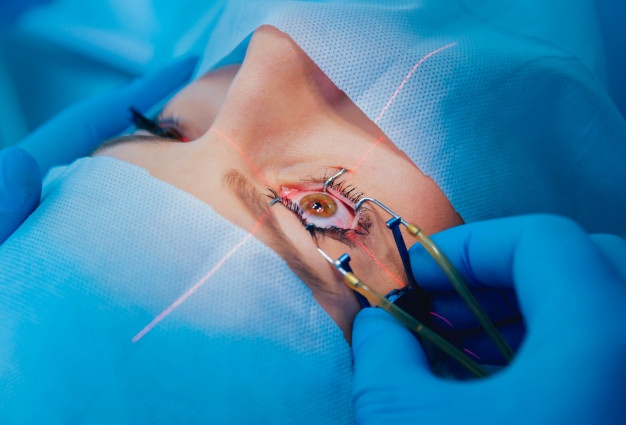Understanding nearsighted laser eye surgery: What you need to know
Nearsightedness, also called myopia, is a common vision condition where close objects appear clear, but distant ones are blurry. Laser eye surgery for nearsightedness is a medical procedure designed to reshape the cornea and correct this blurry distance vision.
There are several types of laser eye surgeries, but the most common ones used to treat myopia include:
-
LASIK (Laser-Assisted In Situ Keratomileusis)
-
PRK (Photorefractive Keratectomy)
-
SMILE (Small Incision Lenticule Extraction)
These surgeries use a highly precise laser to change the shape of the cornea, allowing light entering the eye to be properly focused onto the retina.
Why Nearsighted Laser Eye Surgery Matters Today
Rising Rates of Myopia Globally
Nearsightedness is on the rise. According to the World Health Organization (WHO), nearly half of the global population is projected to be myopic by 2050. The increasing screen time, reduced outdoor activity, and digital dependence have all contributed to this growing issue.
Who Is Affected?
Laser surgery is usually offered to adults over the age of 18 whose prescription has remained stable for at least a year. It is suitable for people with mild to severe myopia, depending on individual eye health.
What Problems Does It Solve?
-
Improved vision without glasses or contact lenses
-
Convenience in daily activities like driving and sports
-
Reduction in the long-term cost of corrective eyewear
While not everyone is a candidate, for those who are, it can mean a major improvement in quality of life.
Recent Updates in Laser Eye Surgery (2024–2025)
New Laser Technologies
In 2024, multiple eye clinics began adopting next-generation femtosecond lasers, which offer even more precision, reduced healing time, and greater comfort. Brands like Alcon’s WaveLight and ZEISS VISUMAX 800 have gained attention in the U.S., Europe, and Asia.
Personalized Treatment Plans
Recent trends show a shift towards customized laser surgery using topography-guided mapping. This technique creates a 3D model of the patient’s cornea for a highly individualized treatment. Clinics in the U.K., U.S., and India have started offering this as a premium service since late 2023.
AI-Assisted Screening
Artificial Intelligence (AI) is now used to assess patient eligibility by analyzing corneal shape, thickness, and risk factors. This improves safety by predicting post-surgery complications like ectasia (corneal weakening).
Remote Consultations
Since early 2024, many eye care providers have offered remote consultations and follow-ups via apps. This has made access easier, especially in rural and semi-urban areas.
Rules, Regulations, and Health Guidelines
Medical Approvals and Standards
Laser eye surgery is regulated differently by country, but generally requires strict compliance with medical board standards:
| Country | Regulatory Authority | Key Guidelines |
|---|---|---|
| USA | FDA (Food & Drug Administration) | Approves specific laser devices for safety and effectiveness |
| UK | MHRA (Medicines and Healthcare Products Regulatory Agency) | Regulates equipment and clinic licensing |
| India | National Medical Commission & DCGI | Requires ophthalmologists to follow standardized procedures |
| Australia | TGA (Therapeutic Goods Administration) | Regulates medical devices used in surgeries |
Many countries have laws requiring patients to be fully informed about risks, side effects, and alternatives. Written consent is mandatory before the procedure.
Insurance Policies
Laser eye surgery is typically not covered by standard health insurance as it is considered elective. However, in some countries like Germany and South Korea, partial reimbursements may be available if the patient has extreme myopia or medical need.
Useful Tools and Resources
Pre-Surgery Assessment Tools
-
Online Vision Tests – Free tools by trusted clinics or platforms like Essilor and CooperVision.
-
Corneal Thickness Calculators – Used to determine if your eyes are suitable for LASIK.
-
Dry Eye Evaluators – Helps screen for dry eye syndrome, which can affect outcomes.
Educational Platforms
-
American Academy of Ophthalmology (AAO) – Offers easy-to-understand guides and videos.
-
NHS (UK) – Provides government-approved information on LASIK and PRK.
-
All About Vision – A well-known site offering detailed articles, cost estimates, and aftercare tips.
Mobile Apps
-
myVisionTrack – Monitors visual acuity and recovery post-surgery.
-
Peek Acuity – A vision screening app used in clinics and homes globally.
Frequently Asked Questions (FAQs)
Q1: Is LASIK surgery painful?
No, LASIK surgery itself is not painful. Numbing eye drops are used, and most patients only feel slight pressure. Mild discomfort or itching may occur for a few hours after the procedure.
Q2: How long is the recovery time?
Most people return to normal activities within 24–48 hours after LASIK. However, full healing may take several weeks, and vision can continue to improve during this period.
Q3: What are the risks or side effects?
Some common side effects include dry eyes, halos, glare, or mild irritation. Serious complications are rare but may include infection or vision regression. Regular check-ups help manage these risks.
Q4: Am I a good candidate for laser eye surgery?
You must be at least 18 years old, have a stable vision prescription, and have healthy corneas. People with autoimmune diseases, dry eye, or very thin corneas may not be eligible.
Q5: How much does it cost?
The cost varies by country and procedure. On average:
-
LASIK: $1,000–$3,000 per eye
-
PRK: $1,200–$2,500 per eye
-
SMILE: $2,000–$3,500 per eye
Prices can also differ based on surgeon experience and technology used.
Conclusion
Laser eye surgery for nearsightedness is a safe and effective procedure that continues to evolve with technology and better screening methods. With rising cases of myopia globally, the demand for surgical correction is growing, making it important for potential patients to understand the process, risks, laws, and resources available.
Always consult with a certified ophthalmologist and ask all necessary questions before deciding on surgery. Educated decisions and proper aftercare are key to achieving the best results.